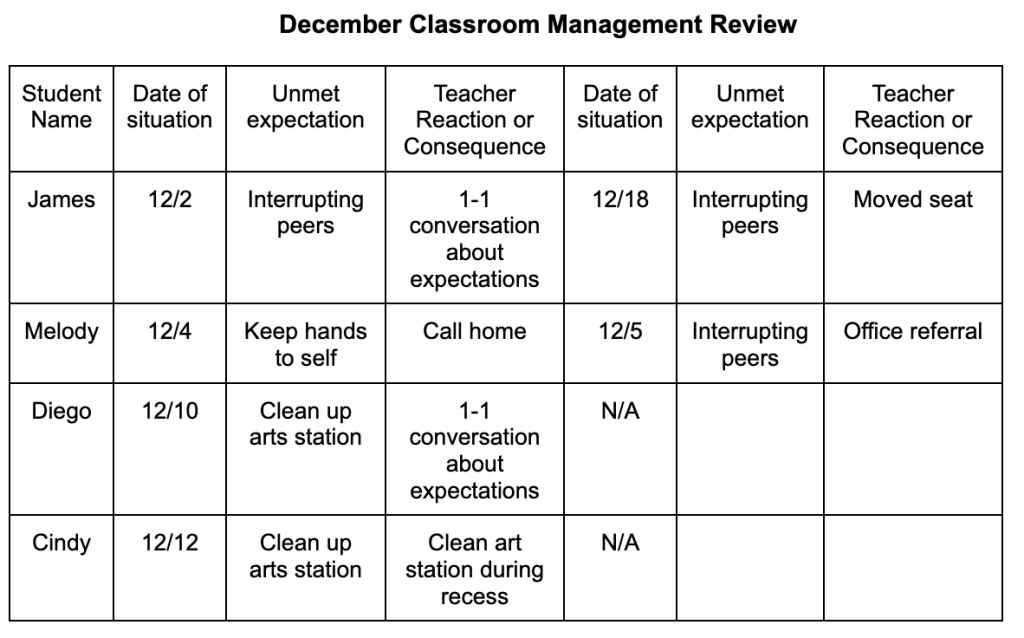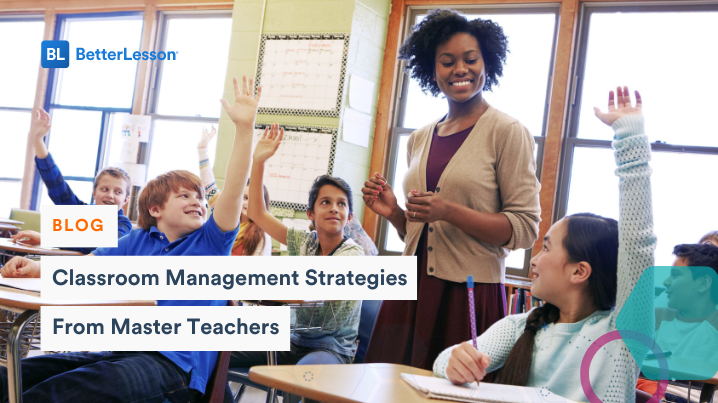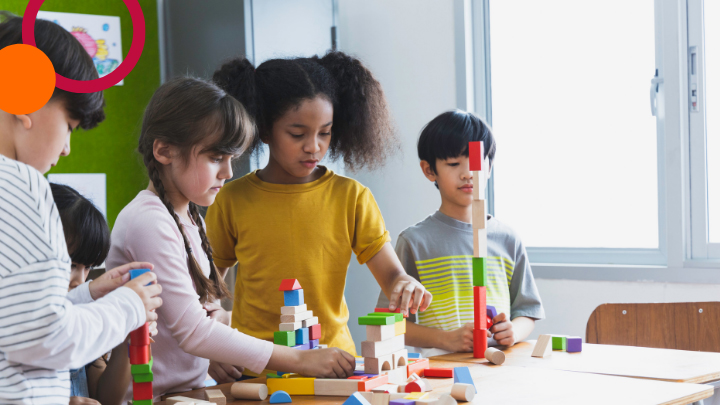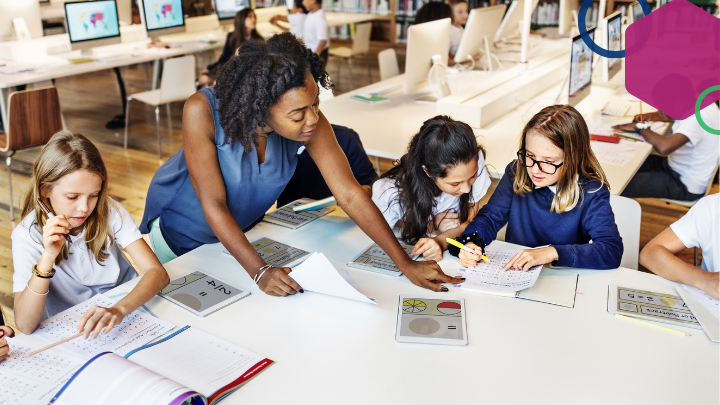One of the most fundamental and consistent roles of a teacher is that of a facilitator. Teachers are tasked with facilitating learning activities, discussions, and assessments everyday. A critical element to this facilitation is classroom management, which is, at its core, a set of practices, norms, and routines that work in tandem to maintain positive and productive classroom environments in which students are at the center of their own learning. In this blog post, we’ll explore some key classroom management strategies utilized by exemplary teachers.
Why Classroom Management?
Classrooms are, essentially, communities: groups of people who are navigating interpersonal dynamics, working together, and building relationships. Like any community, there must be thoughtful, strategic, and considerate leadership to maintain a positive and functioning environment. In this way, classroom management can also be understood as community-building, the practice of building trust, connection, and respect. This is where teachers come in.
We know from research that classroom management can have deep impacts on schools in classrooms. Teachers who struggle with classroom management are more likely to leave the profession. Additionally, there is a clear relationship between classroom management practices and student academic performance. Moreover, effective classroom management creates the conditions for students to feel safe, confident, and willing to take academic risks – a core value of any teacher!
Drawing from BetterLesson’s Instructional Strategies, let’s look at specific strategies and tools that can support effective classroom management.
Strategy #1: Build Strong Relationships
Relationship-building is a fundamental component of classroom management. If teachers don’t have positive relationships with their students – characterized by care, empathy, and mutual respect – then classroom management becomes exclusively an act of control, rather than an act of facilitation and connection. This dynamic of control often breeds resentment and dissent among students, leading to more behavioral issues and concerns.
Instead, when teachers prioritize relationship-building as an ongoing practice of investing in a positive classroom community, classroom management becomes an easier, more organic process.
When teachers have strong relationships, then students are more receptive to other critical aspects of classroom management: routines, expectations, procedures, etc.
Examples: Check In Check Out & Get To Know Your Students All Year
Check In Check Out: The Check In Check Out (CICO) strategy is a practice of care, support, and accountability. This strategy can have various levels of intervention. For students with higher academic and/or social-emotional needs, CICO can be used on a one-on-one basis. This might look like the student checking-in with a mentor teacher at the start of each week – engaging in a reflective check-in question, reviewing goals for the week, and setting expectations. Then, at the end of the week, the student will check-out with the mentor teacher – reflecting on the week and its successes and challenges. On the other hand, as a broader strategy, a classroom teacher might start each week with a check-in question to get a sense of the students’ academic, social, and/or emotional needs, and then end each week with a check-out question to encourage reflection on the week. While this strategy has a lot of flexibility, the general premise is to ensure that students have recurring access to positive interactions and opportunities for self-reflection. Check out this strategy for specific resources to support implementation.
Get To Know Your Students All Year: Oftentimes, get-to-know-you activities are framed as a one-and-done practice at the beginning of each school year. However, real relationships are rooted in ongoing opportunities to build trust, connection, and respect. With this strategy, teachers are equipped with practices to get to know their students all year round. Additionally, this strategy takes traditional get-to-know-you activities and deepens them by imbedding information teachers learn about their students (interests, learning styles, skills, hobbies, etc.) into their classroom activities. This strategy contains multiple resources to support teachers’ facilitation of these activities.
Strategy #2: Establish Clear Expectations
Having clear expectations for students is critical for effective classroom management. If students don’t understand what is expected of them academically and socially, we can’t blame them when they don’t meet those expectations. Additionally, being clear and explicit about expectations allows opportunities for learning conversations. In other words, when a student doesn’t meet expectations, rather than resort automatically to punishments, teachers can have constructive conversations with the established expectations as the north star for those conversations.
Examples: Shared Work Time Norms and Expectations & Developing and Evaluating Rules with an Equity Lens
Shared Work Time Norms and Expectations: When expectations are decided unilaterally by teachers, students can feel disempowered and voiceless. With this strategy, teachers facilitate a process by which students co-create norms and expectations for how to engage in group work. By participating in this process, students feel not only more empowered, but they feel more clear about the expectations themselves, as they were involved in their creation.
Developing and Evaluating Rules with an Equity Lens: Approaching expectations with an equity lens is critical to ensure inclusivity and fairness. With this strategy, the teacher facilitates a process by which students share their own understandings of respect (what it looks like, feels like, sounds like, etc.) and then work together to develop a set of expectations that are rooted in each student’s understanding of respect.
Strategy #3: Classroom Routines and Procedures
Having clear classroom routines and procedures can help eliminate opportunities where behavioral issues and conflicts occur. If students are clear about basic classroom functions – the flow of each lesson, what to look for at the start of class, how to close out class, how and when to access supplies and resources – lessons will undoubtedly run more smoothly.
Examples: Modeling and Repeated Practice of Expectations, Routines, and Procedures & Giving Students a Voice in Classroom Procedures
Modeling and Repeated Practice of Expectations, Routines, and Procedures: With this strategy, teachers are encouraged first to think critically about their routines and procedures, ensuring that instead of demanding compliance and quiet, they are established to promote collaborative and engaging learning experiences. From here, the strategy provides actionable steps for how teachers can explicitly communicate and model their routines and procedures. This level of intentionality and practice helps students be successful in class.
Giving Students a Voice in Classroom Procedures: When students have opportunities to co-create classroom procedures, they feel more ownership over them, and in turn, are more motivated to follow them. This strategy walks teachers through a process by which students can reflect on current classroom procedures, offer their own ideas and input, and collaboratively create their own procedures.
Strategy #4: Being Consistent and Fair
The work doesn’t end with setting clear expectations and procedures; rather, the work continues by being fair and consistent in how we enforce those expectations. Here, it is critical for teachers to engage in ongoing reflection on how they are/are not maintaining expectations. Research has consistently shown that racial and gender biases, often unconscious, impact how teachers engage with their students, leading, for example, to students of color being disproportionately disciplined and girls being called on less than boys. When we encourage teachers to reflect on their classroom management practices, we can work to expose and combat these inequities and biases.
Strategy: Systematic Review of Classroom Management Activities
With this strategy, teachers can periodically take stock on their classroom management activities. For example, for a particular month, a teacher might create a log of their classroom management activities. The log contains a list of each student, with tabs to log interactions related to classroom management. It could look something like this:

Engaging in this systemic level of reflection is important for identifying patterns and biases in your own practices: Are students of color being disproportionately disciplined? Are particular students receiving harsher punishments for the same behavior than other students? While this reflective practice can reveal some difficult truths, it is necessary for ensuring fairness, consistency, and equity.
Strategy #5: Use Restorative Justice Practices
Oftentimes, behavioral issues are emblematic of larger issues: conflicts between students, difficulties with emotional regulation, miscommunication, or unclear expectations. At best, discipline and punishment responses can ignore these potential underlying causes of behavioral issues, but at worst, they can exacerbate them and create larger, more persistent challenges.
Restorative justice practices are a set of tools that look at behavior issues through a lens of harm and accountability: Who was harmed? Who caused harm? What caused this? How can we repair the harm? These practices prioritize relationship- and community-building and facilitate hard conversations that can help support students grow and learn from challenges and conflicts.
Example: Restorative Circles
Restorative Circles are a specific practice used in restorative justice. Circles can be used in two-ways: proactively and responsively. As a proactive practice, circles can be used to build trust and community, so that when conflicts and behavioral issues inevitably occur, teachers and students have a positive foundation from which to address them.
With a proactive circle, a teacher might start class once a week with the entire class – including the teacher – arranged in a circle. The teacher, or a student, will ask a check-in question, and each student will go around the circle and share an answer. The circle formation is integral to this practice, as it allows everyone to be seen and creates a more level-playing field.
As a responsive practice, restorative circles can be used to address a particular conflict. In the instance of bullying, a teacher or a restorative facilitator might call for a circle. Here, the student who caused harm is able to hear directly from the student who was harmed. Through a heavily-facilitated dialogue, the students can work together to understand the root cause of this conflict and identify a solution moving forward.
Strategy #6: Build Relationships with Families
Classroom management extends beyond the classroom. By building relationships with families and caretakers, teachers can learn more about their students, create deeper relationships, and establish a wider network of care and support for students.
Examples: Communicating Positive News to Families & Family Partnership Plan
Communicating Positive News to Families: Unfortunately, most parents/caretakers receive calls from school to report negative feedback (i.e. their child is in trouble, their child is failing a class, etc.). When we limit our interactions with families to negative news, we create an adversarial relationship with families, and by extension, with students. Instead, teachers can prioritize positive contacts with families to share successes, improvements, and encouragements. This can be done through phone calls or through technological tools (i.e. email, shared Google Docs, parent communication apps). These forms of communication can help build trust and respect between teachers and families/students.
Family Partnership Plan: A Family Partnership Plan is a more comprehensive, school-wide approach to building relationships with families. Within this strategy, you will find resources to help assess your school’s current level of family-school partnership and tools for building out robust family partnership programs, including Parent-Teacher Home Visits and Academic Parent-Teacher Teams.
Strategy #7: Positive Reinforcement
Despite the best intentions, when teachers focus primarily on behavioral issues and negative interactions, they inadvertently have counterproductive impacts: fractures in teacher-student relationships, negative classroom environment, and sometimes even reinforcing behavioral issues. While it’s important to address instances when students aren’t meeting expectations, it is equally important to call attention to times when students do meet expectations. By emphasizing these moments, we create a more positive classroom culture, provide more encouragement, and call attention to our expectations (rather than the absence of our expectations).
Example: Charting Positive Strengths to Build Relationships
With all the responsibilities of teaching, it can be easy for teachers to lose sight of positive reinforcements. This strategy provides resources for teachers to chart their students’ positive strengths and track communication. This helps to streamline and systematize the process of communicating positive strengths and behaviors, which can dramatically improve teacher-student relationships.
Strategy #8: Maintaining Engagement
When students are disengaged in their own learning, they are more likely to engage in disruptive behavior. On the other hand, if students are engaged in their own learning, they are more likely to naturally follow classroom expectations and procedures because they want to be learning. In this way, maintaining authentic engagement is a powerful proactive classroom management strategy.
Examples: Genius Hour & Developing Project-Based Learning in your Classroom
Genius Hour: With Genius Hour, students are supported in designing, implementing, and managing their own learning project based on their own interests. This level of autonomy and encouraged-curiosity can be incredibly motivating for students. In this strategy, there are resources – Plan Sheets, Rubrics, and Research Evaluation Tools – for teachers to implement Genius Hour projects with the necessary support.
Developing Project-Based Learning in your Classroom: Project-based learning is a powerful and engaging approach to learning. With this approach, students are encouraged to tackle real-world problems through student-generated inquiries. In this strategy, teachers can find resources to unpack the nine strategies for effective project-based learning.
These strategies are only a starting point for the robust set instructional strategies and resources that BetterLesson provides in support of positive classroom management. BetterLesson also offers a range of personalized professional learning opportunities – one-on-one coaching, learning walks, in-person and virtual workshops – that can facilitate the implementation of impactful classroom management strategies.
Schedule a call with us today to learn more about how we can work together to support school-wide positive classroom management practices.
Get in Touch







